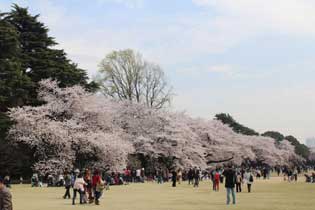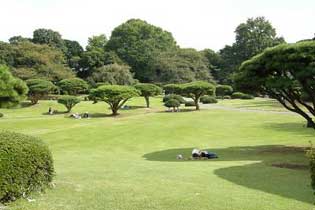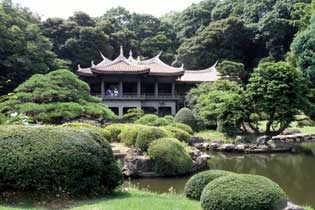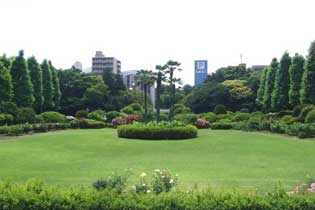
Travel Guide
Introduction
Shinjuku Gyoen is one of Tokyo's largest and most popular parks. The former name is "Shinjuku Gyoen National Garden".
Located just 5 minutes’s walk from Shinjuku Station, it functions as an oasis in the middle of Shinjuku with the spacious lawns, meandering walking paths, gardens, lakes, teahouses, and in the background Shinjuku’s skyscrapers. There is a belt of trees surrounding the park that blocks a large amount of the city sounds. That belt really allows a contrast to become easily visible. In spring Shinjuku Gyoen becomes one of the best places in the city to see cherry blossoms.


The park is divided into three distinctive gardens: Japanese Traditional, French Formal and English Landscape.
The oldest is a traditional Japanese landscape garden featuring large ponds dotted with islands and bridges. Well manicured shrubs and trees surround the water together with several pavilions and the Kyu Goryotei (also called the Taiwan Pavilion) which was built on the occasion of the wedding of the Showa Emperor. A chrysanthemum exhibit is held during the first two weeks of November in the Japanese garden with flower displays and large, temporary pavilions erected around the grounds.
The park's other main gardens include a symmetrically arranged formal French garden, and an English landscape garden featuring wide, open lawns surrounded by flowering cherry trees. It is a great feeling to stand in English landscape garden and just enjoy the peacefulness there (especially on a weekday when the park is not so busy). The rest of the park consists of forested areas, lawns and several structures including a restaurant, an information center and an art gallery. There is also a beautiful greenhouse with many tropical and subtropical flowers.
Shinjuku Gyoen is home to a large number of cherry trees of more than a dozen different varieties. From late March to early April, more than 400 somei yoshino trees blossom around the English garden turning the lawns into one of Tokyo's most popular and pleasant hanami spots. In addition, the park has numerous early and late blooming cherry trees which provide an extended cherry blossom viewing season (mid March to late April) for those who miss the main season. During the cherry blossom season, the central lawn areas are particularly stunning. Consider bringing a picnic lunch.
Shinjuku Gyoen is also nice to visit during autumn when the leaves change. There are a lot of different types of trees that change colors around the park, however the maple trees are particularly beautiful and can be seen in large numbers around the Japanese garden and Momijiyama (maple mountain) on the park's eastern side. The colors typically appear from mid November to mid December.


History
The great warlord Tokugawa Ieyasu grant Shinjuku Gyoen to his vassals Naito Kiyoshige in 1590 as Naito's Tokyo residence. Later it was converted into a botanical garden before being transferred to the Imperial Family in 1903 who used it for recreation and the entertainment of guests. The park was almost completely destroyed during World War II. It was on May 21, 1949 that the gardens became open to the public as "National park Shinjuku Imperial Gardens". It came under the jurisdiction of the Ministry of the Environment in January, 2001 with the official name "Shinjuku Gyoen National Garden".
Travel Advice
You can bring your leisure sheet, food and drink for picnic or hanami party in the park but no alcohol as it is prohibited. You can buy your food or drink outside the park. If you are wondering what a leisure sheet is, it’s like a picnic rug that you sit on, but made of plastic often blue or green in colour that most people here sit on.
Visit
| Address | 11 Nito-cho, Shinjuku-ku, Tokyo | |
| Phone | 03-3341-1461 | |
| Admission | Senior: 250 yen Adult: 500 yen Student: 250 yen |
Senior: over 65 Adult: over 15 Student: elementary and junior high |
| Hours | 09:00 to 16:30 Oct 1 to Mar 14 09:00 to 18:00 Mar 15 to Jun 30, Aug 21 to Sep 30 09:00 to 19:00 Jul 1 to Aug 20 |
Entry until 30 minutes before closing |
| Closed | Every Monday. The following day if a public holiday falls on the day. December 29 to January 3 |
|
| Duration | 20 minutes | |
| Getting There | By Train 10 minutes walk from Shinjuku Station on JR Lines, Keio Line or Odakyu Line. 15 minutes walk from Seibu-shinjuku Station on Seibu-shinjuku Line. 5 minutes walk from Shinjuku-gyoen Station on subway Marunouchi Line. 5 minutes walk from Shinjuku-sanchome Station on subway Shinjuku Line. By Car Take Shuto Expressway to the Gaien exit. It is approximately 2 kilometers, 7 minutes from exit. |
|
| Parking | Paid parking available | |

